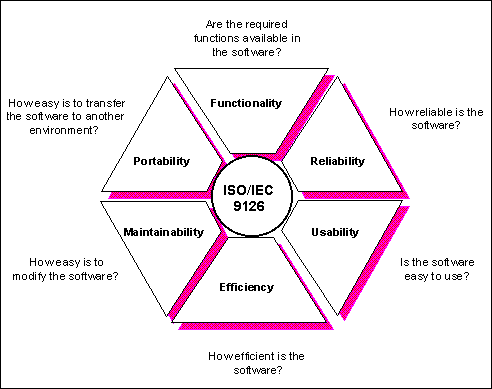 |
ISO 9126: The Standard of ReferenceISO/IEC 9126 : Information technology - Software Product Evaluation - Quality characteristics and guidelines for their use - 1991. |
 |
ISO 9126: The Standard of ReferenceISO/IEC 9126 : Information technology - Software Product Evaluation - Quality characteristics and guidelines for their use - 1991. |
The objective of this standard is to provide a framework for the evaluation of software quality. ISO/IEC 9126 does not provide requirements for software, but it defines a quality model which is applicable to every kind of software. It defines six product quality characteristics and in an annex provides a suggestion of quality subcharacteristics.

The six quality characteristics of a software.
| Characteristics | Subcharacteristics | Definitions |
|---|---|---|
| Suitability | Attributes of software that bear on the presence and appropriateness of a set of functions for specified tasks. | |
| Accurateness | Attributes of software that bear on the provision of right or agreed results or effects. | |
| Functionality | Interoperability | Attributes of software that bear on its ability to interact with specified systems. |
| Compliance | Attributes of software that make the software adhere to application related standards or conventions or regulations in laws and similar prescriptions. | |
| Security | Attributes of software that bear on its ability to prevent unauthorized access, whether accidental or deliberate, to programs or data. | |
| Maturity | Attributes of software that bear on the frequency of failure by faults in the software. | |
| Reliability | Fault tolerance | Attributes of software that bear on its ability to maintain a specified level of performance in case of software faults or of infringement of its specified interface. |
| Recoverability | Attributes of software that bear on the capability to re-establish its level of performance and recover the data directly affected in case of a failure and on the time and effort needed for it. | |
| Understandability | Attributes of software that bear on the users’ effort for recognizing the logical concept and its applicability. | |
Usability | Learnability | Attributes of software that bear on the users’effort for learning its application. |
| Operability | Attributes of software that bear on the users’effort for operation and operation control. | |
Efficiency | Time behaviour | Attributes of software that bear on response and processing times and on throughput rates in performances its function. |
| Resource behavior | Attributes of software that bear on the amount of resource used and the duration of such use in performing its function. | |
| Analyzability | Attributes of software that bear on the effort needed for diagnosis of deficiencies or causes of failures, or for identification of parts to be modified. | |
| Maintainability | Changeability | Attributes of software that bear on the effort needed for modification, fault removal or for environmental change. |
| Stability | Attributes of software that bear on the risk of unexpected effect of modifications. | |
| Testability | Attributes of software that bear on the effort needed for validating the modified software. | |
| Adaptability | Attributes of software that bear on the opportunity for its adaptation to different specified environments without applying other actions or means than those provided for this purpose for the software considered. | |
| Portability | Installability | Attributes of software that bear on the effort needed to install the software in a specified environment. |
| Conformance | Attributes of software that make the software adhere to standards or conventions relating to portability. | |
| Replaceability | Attributes of software that bear on opportunity and effort using it in the place of specified other software in the environment of that software. | |
This material is reproduced from ISO/IEC 9126:1991. No part of these terms and definitions may be reproduced in any form, electronic retrieval system or otherwise without the prior written consent of ISO, (Case postale 56, 1211 Geneva 20, Switzerland, Fax +41 22 734 10 79) or of the ISO national member bodies.
New edition:
The current standard is under review. The proposed new edition of ISO/IEC 9126 will be divided into three parts:
ISO/IEC 9126-1: Information technology - Software quality characteristics and metrics - Part 1: Quality characteristics and subcharacteristics.
This part provides the concepts introduced in the original standard ie a recommended quality model which categorizes software quality in six characteristics, which are further sub-divided into subcharacteristics. The subcharacteristics have been moved from the annex to become part of the standard. They have been reworded and several new ones added. There is also a definition of quality in use which defines the user's view as a result of using the software.
ISO/IEC 9126-2: Information technology - Software quality characteristics and metrics - Part 2: External metrics.
This part provides external metrics for measuring software quality characteristics. An external metric is a quantitative scale and measurement method, which can be used for measuring an attribute or characteristic of a software product, derived from the behaviour of the system of which it is a part. External metrics are applicable to an executable software product during testing or operating in later stage of development and after entering to operation process.
ISO/IEC 9126-3: Information technology - Software quality characteristics and metrics - Part 3: Internal metrics.
This part provides internal metrics for measuring software quality characteristics. An internal metric is a quantitative scale and measurement method, which can be used for measuring an attribute or characteristic of a software product, derived from the product itself, either direct or indirect (it is not derived from measures of the behaviour of the system). Internal metrics are applicable to a non executable software product during designing and coding in early stage of development process.
| Overview | |
| Quality Characteristics |